|

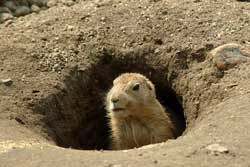 Burrow Dwellers: Marmots typically live in burrows, and hibernate there through the winter. Most marmots are highly social, and use loud whistles to communicate with one another, especially when alarmed. Many historians suggest that marmots, rather than rats, were the primary carriers of the Bubonic plague during several historic outbreaks. Burrow Dwellers: Marmots typically live in burrows, and hibernate there through the winter. Most marmots are highly social, and use loud whistles to communicate with one another, especially when alarmed. Many historians suggest that marmots, rather than rats, were the primary carriers of the Bubonic plague during several historic outbreaks.
----------------------------------------------------------------------------------------------------------------------------
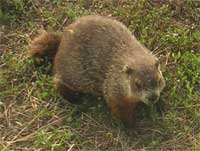 The Groundhog (Marmota monax), also known as the Woodchuck, or the Whistlepig (particularly in the Southern United States), is a rodent of the family Sciuridae, belonging to the group of large ground squirrels known as marmots. Most marmots live in rocky and mountainous areas, but the Woodchuck is a lowland creature. It is widely distributed in North America; for example, it is found in Alaska, Alabama, and Georgia. In the west it is found only in Alaska, Alberta, British Columbia and northern Washington. In the United States and Canada, there is a Groundhog Day celebration that gives the groundhog some added popularity. The Groundhog (Marmota monax), also known as the Woodchuck, or the Whistlepig (particularly in the Southern United States), is a rodent of the family Sciuridae, belonging to the group of large ground squirrels known as marmots. Most marmots live in rocky and mountainous areas, but the Woodchuck is a lowland creature. It is widely distributed in North America; for example, it is found in Alaska, Alabama, and Georgia. In the west it is found only in Alaska, Alberta, British Columbia and northern Washington. In the United States and Canada, there is a Groundhog Day celebration that gives the groundhog some added popularity.
Weights and Measures: Groundhogs are typically 40 to 65 cm long (including a 15 cm tail) and weigh 2 to 4 kg. In areas with fewer natural predators and large quantities of alfalfa, they can grow to 32 inches (80 cm) and 30 lb (14 kg). They can live up to six years in the wild, and ten years in captivity.
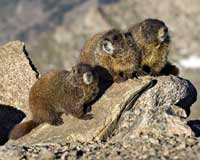 Growing Numbers: The groundhog is one of a small number of species that have grown greatly in numbers since the arrival of European settlers in North America, since the clearing of forests provided it with much suitable habitat. It prefers open country and the edges of woodland. As a consequence, it is a familiar animal to many people in the United States and Canada. Growing Numbers: The groundhog is one of a small number of species that have grown greatly in numbers since the arrival of European settlers in North America, since the clearing of forests provided it with much suitable habitat. It prefers open country and the edges of woodland. As a consequence, it is a familiar animal to many people in the United States and Canada.
Excellent burrowers: Groundhogs are excellent burrowers, using burrows for sleeping, rearing young, and hibernating. The burrows generally have two exits, and the groundhog rarely ventures far from one of them for safety. While preferring to flee from would-be predators, the groundhog is known to viciously defend its burrow when invaded by predators such as skunks, foxes, weasels or domestic dogs. It can inflict quite a bit of damage with its two large incisors and front claws, especially when the predator is at a disadvantage inside the burrow.
Breeding: Usually groundhogs breed in their second year, but a small percentage may breed as yearlings. The breeding season extends from early March to middle or late April, following hibernation. A mated pair will remain in the same den throughout the 28-32 day gestation period. As birth of the young approaches in April or May, the male will leave the den. One litter is produced annually, usually containing 2-6 blind, naked and helpless young. Young groundhogs are weaned and ready to seek their own dens at five to six weeks of age.
----------------------------------------------------------------------------------------------------------------------
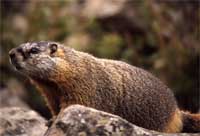 The Yellow-bellied Marmot (Marmota flaviventris), also known as the "Rock Chuck", is a ground squirrel in the marmot genus. It lives in the mountains of the western United States and Canada, including the Rocky Mountains and the Sierra Nevada. It inhabits subalpine and alpine regions, typically above 2000 m of elevation. The Yellow-bellied Marmot (Marmota flaviventris), also known as the "Rock Chuck", is a ground squirrel in the marmot genus. It lives in the mountains of the western United States and Canada, including the Rocky Mountains and the Sierra Nevada. It inhabits subalpine and alpine regions, typically above 2000 m of elevation.
Sizes and Scales:
Yellow-bellied Marmots usually weigh between 5 and 11 pounds (2 and 5 kg) when fully grown. They get fatter in the fall just before hibernating. A marmot’s habitat is mostly grass and rocks with few trees. Their territory is about 20,000 to 30,000 square metres (about 6 acres) around a number of summer burrows.
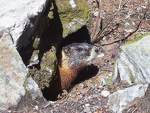 Under A Rock: Marmots choose to dig burrows under rocks because predators are less likely to see their burrow. Predators include wolves, foxes, and coyotes. When a marmot sees a predator it whistles to warn all other marmots in the area (giving it the common name the whistle pig). Then it typically hides in a nearby rock pile. Under A Rock: Marmots choose to dig burrows under rocks because predators are less likely to see their burrow. Predators include wolves, foxes, and coyotes. When a marmot sees a predator it whistles to warn all other marmots in the area (giving it the common name the whistle pig). Then it typically hides in a nearby rock pile.
Marmot Social Lives: Marmots reproduce when about 2 years old. They live in colonies. A colony is a group of about 10 to 20. Each male marmot digs a burrow soon after he wakes up from hibernation. He then starts looking for females and by summer has 1 to 4 females living with him. Litters usually average 2-5 offspring per female. Marmots have what is called “harem-polygynous” which means the male defends 1-4 mates at the same time.
Yellow-bellied Marmots are diurnal like most mammals. The marmot is also an omnivore, eating grass, leaves, flowers, fruit, grasshoppers, and bird eggs.
Marmots are not hunted for sport but are sometimes killed by farmers.
All text is available under the terms
of the GNU Free Documentation License
|